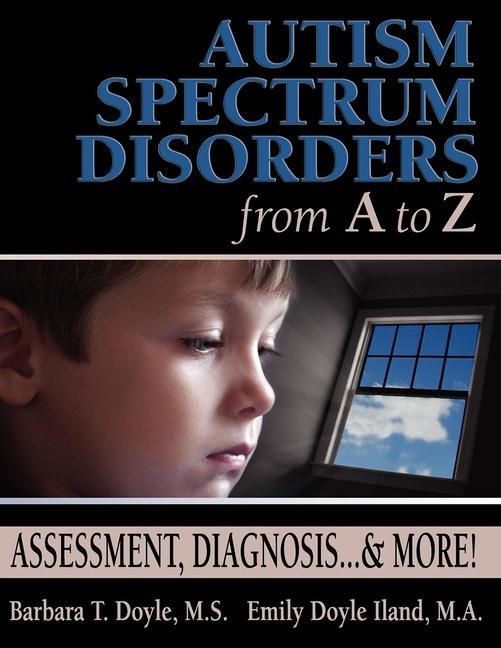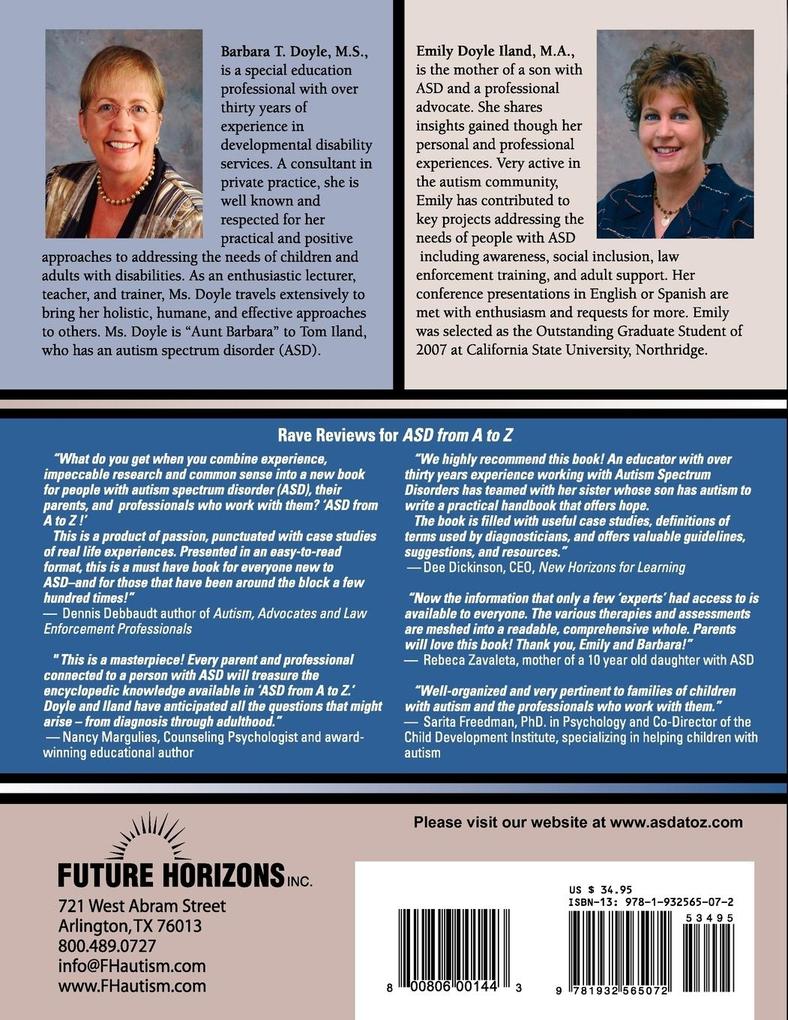
Zustellung: Sa, 19.07. - Do, 24.07.
Versand in 2 Wochen
VersandkostenfreiBestellen & in Filiale abholen:
This extremely comprehensive book goes step-by-step through the symptoms, definitions, assessments, and diagnoses of autism spectrum disorders (ASDs). The authors describe ASDs in terms of the parents, teachers, the school system, medical professionals, adult service providers, and private agencies involved. In addition to revealing what parents and professional can expect, this book also provides practical strategies to improve the assessment process and help the child or adult deal with the stress of the evaluations. Finally, they tackle the controversial issues surrounding the causes of ASD and available treatment options.
Inhaltsverzeichnis
Dedication
Disclaimer
Introduction
About the authors
Introduction from Emily
Introduction from Barbara
Purpose of the book
Terms used
Who this book is intended to help
Who should read this book?
Chapter One: Understanding Autism Spectrum Disorders (ASD)
The Diagnostic Process
Pervasive Developmental Disorder (PDD): the Umbrella Category
PDD and ASD Overlap and Are Often Used Interchangeably
Discussion of the Term "ASD"
Characteristics of ASD
Range of Effects
Table 1.1, The Range of Effects in ASD
Common Misperceptions About ASD
Implications of ASD
Learning Strengths and Areas of Difficulty of People with ASD
Chapter Summary
Chapter Two: Considerations in the Diagnosis of ASD
Recognizing the Need to Get a Professional Opinion
Making the Connection with ASD
Difficulty and Differences Using Diagnostic Terms
Differential Diagnosis
Barriers to Accurate Diagnosis: Not Recognizing Autism
ASD, By Many Other Names
"Labels" Within ASD
What Difference the Diagnosis Makes
Diagnostic Criteria, Explained
Autistic Disorder
Pervasive Developmental Disorder
Asperger Syndrome (AS)
AS and High Functioning Autism (HFA): Same or Different?
ASD and ADD Similarities
ASD and ADD Differences
Autism Spectrum Disorder (ASD) and
Attention Deficit Disorder (ADD)?
Questions to Ask
ADHD Criteria
ASD and Hyperlexia
ASD, Semantic Pragmatic Disorder and
Nonverbal Learning Disorder
Autism Spectrum Disorder and Cognitive Disabilities
Chapter Summary
Sources
Chapter Three: Beginning the Process of Assessment and Diagnosis
Options in Diagnosis: Who Can Diagnose
The Role of the School System
The Role of the Parent
The Role of Adult Service Providers and Agencies
Options for Adults Referring Themselves for Diagnosis
Emotions and the Assessment Process
How Parents Can Help Professionals with the Diagnostic Process
Preparing a Written Personal History
Adults Piece the Puzzle Together
What to Include in the Developmental History
3.1 Matt's Story
3.2 Laura's Timeline
3.3 About Alex
The Role of Teachers
Chapter Summary
Sources
Chapter Four: The Assessment Process
What is an Assessment?
The Purpose of Assessment
4.1, The Assessment Cycle
Components of a Comprehensive Assessment
The Assessment Team
Challenges in the Assessment Process for Professionals, Parents and Individuals
Disclaimer
Introduction
About the authors
Introduction from Emily
Introduction from Barbara
Purpose of the book
Terms used
Who this book is intended to help
Who should read this book?
Chapter One: Understanding Autism Spectrum Disorders (ASD)
The Diagnostic Process
Pervasive Developmental Disorder (PDD): the Umbrella Category
PDD and ASD Overlap and Are Often Used Interchangeably
Discussion of the Term "ASD"
Characteristics of ASD
Range of Effects
Table 1.1, The Range of Effects in ASD
Common Misperceptions About ASD
Implications of ASD
Learning Strengths and Areas of Difficulty of People with ASD
Chapter Summary
Chapter Two: Considerations in the Diagnosis of ASD
Recognizing the Need to Get a Professional Opinion
Making the Connection with ASD
Difficulty and Differences Using Diagnostic Terms
Differential Diagnosis
Barriers to Accurate Diagnosis: Not Recognizing Autism
ASD, By Many Other Names
"Labels" Within ASD
What Difference the Diagnosis Makes
Diagnostic Criteria, Explained
Autistic Disorder
Pervasive Developmental Disorder
Asperger Syndrome (AS)
AS and High Functioning Autism (HFA): Same or Different?
ASD and ADD Similarities
ASD and ADD Differences
Autism Spectrum Disorder (ASD) and
Attention Deficit Disorder (ADD)?
Questions to Ask
ADHD Criteria
ASD and Hyperlexia
ASD, Semantic Pragmatic Disorder and
Nonverbal Learning Disorder
Autism Spectrum Disorder and Cognitive Disabilities
Chapter Summary
Sources
Chapter Three: Beginning the Process of Assessment and Diagnosis
Options in Diagnosis: Who Can Diagnose
The Role of the School System
The Role of the Parent
The Role of Adult Service Providers and Agencies
Options for Adults Referring Themselves for Diagnosis
Emotions and the Assessment Process
How Parents Can Help Professionals with the Diagnostic Process
Preparing a Written Personal History
Adults Piece the Puzzle Together
What to Include in the Developmental History
3.1 Matt's Story
3.2 Laura's Timeline
3.3 About Alex
The Role of Teachers
Chapter Summary
Sources
Chapter Four: The Assessment Process
What is an Assessment?
The Purpose of Assessment
4.1, The Assessment Cycle
Components of a Comprehensive Assessment
The Assessment Team
Challenges in the Assessment Process for Professionals, Parents and Individuals
Produktdetails
Erscheinungsdatum
01. Januar 2004
Sprache
englisch
Seitenanzahl
462
Autor/Autorin
Barbara T Doyle, Emily Doyle Iland
Verlag/Hersteller
Produktart
kartoniert
Gewicht
1134 g
Größe (L/B/H)
277/216/18 mm
ISBN
9781932565072
Bewertungen
0 Bewertungen
Es wurden noch keine Bewertungen abgegeben. Schreiben Sie die erste Bewertung zu "Autism Spectrum Disorders from A to Z" und helfen Sie damit anderen bei der Kaufentscheidung.










